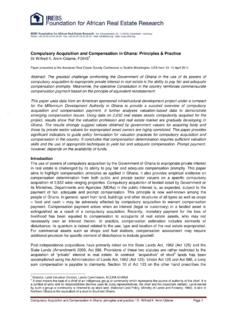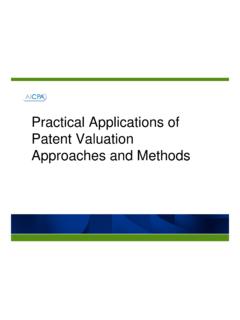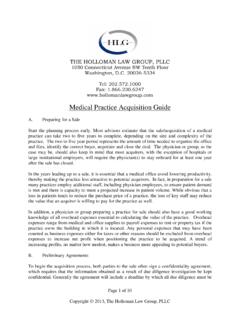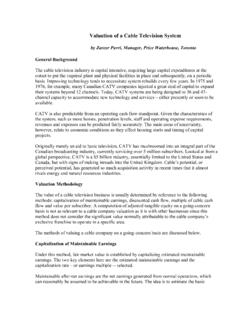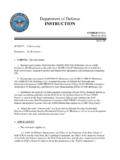Transcription of Part A : Valuation of Share of a Closely Held Company
1 Part A : Valuation of Share of a Closely Held Company ( including Debt) Part B : Valuation under Various Legislations Prepared by: CA Manoj Aggrawal ( 84769 , Mobile 98100 46153) CA Megha Almadi ( 510375) CA Tarun Sharma ( ) CA Jitesh Bhugra ( ) CA Love Mangla ( ) Private & Confidential Part A : Valuation of Share of a Closely Held Company ( including Debt) Contents 1. Background of the Case 6 2. The Valuation Assignment 7 Client and Valuer Date of Retention Definition of Property to be Valued Ownership Characteristics Effective date of Valuation Purpose Standard ( Definition) of Value Premise of Value 3. Revenue Ruling 59 60 9 4. Valuation Methodologies and Approach 10 A. Adjusted Net Asset Method ( NAV ) Asset Approach 10 Methodology Control Vs.
2 Minority Valuation Discounts DLOC and DLOM Value Indication B. Discounted Cash Flow APV Approach Income Approach 13 Cost of Capital ApproachVs. APV approach APV Approach Methodology Normalization of Historical results and Averaging Forecasting future cash flows to invested capital Estimating unlevered Beta Estimating Cost of Unlevered equity ( Modified CAPM) Market Valuation of Debt and Computation of Cost of Debt Computation of Firm s Value as per APV approach, Value to Equity & Value of Share Discounts DLOM & DLOC Value Indication C. Guideline Public Company Method Market Approach 20 Methodology Market Value of Equity ( MVE) Multiples Market Value of Invested Capital ( MVIC or BEV) Multiples Control Vs. Minority Discounts DLOC and DLOM D. Statutory Valuations 24 Erstwhile CCI Formula FEMA Guidelines 5.
3 Source of Information 29 6. Caveats 30 7. Distribution of Report 32 8. Correlation and Reconciliation of Valuation 33 Methods and Sanity Check 9. Value conclusion 37 Appendix : A. Conditions And Major Assumptions 38 B. Valuation Certification and Signature - 39 Part B : Valuation under Various Legislations Contents 1. Valuation of Equity Shares according to guidelines 44 issued by the erstwhile Controller of Capital Issues. A. Applicability B. Methodology in brief Compute Net Asset Value Compute Profit Earning Capacity Value ( PECV) Fair Value C. Case Study 2. Valuation of Equity Shares according to FEMA guidelines. 51 A. Applicable Methodologies Issue of Shares Transfer of Shares B. Case Study 3. Valuation of Equity Shares according to 56 SEBI guidelines SEBI (Substantial Acquisition of Shares and Takeover) Regulations, 1997.
4 A. Regulatory Provisions When the shares of Target Company are frequently traded Where the shares of the target Company are infrequently traded B. Case Study 4. Valuation of Equity Shares/ FCDs /PCDs in 63 their Preferential issue according to SEBI guidelines SEBI (DIP) Guidelines, 2000. A. Guidelines For Preferential Issues B. Case Study 5. Valuation under Wealth Tax 69 A. Immovable Property (Rule 3 to 8, Schedule III, Part B) Determine gross maintainable rent (GMR) Determine Net Maintainable rent (NMR) Capitalize NMR Value of Property Adjustments to value arrived for unbuilt area of plot of land Adjustment for unearned increase in the value of the land B. Valuation of Assets Of Business (Rule 14, Part D, Schedule III) 6. Valuation of Equity Shares Under the Companies Act, 1956 73 1.
5 Background of the Case and Purpose M/s K Electro-Chemicals Private Limited, (KECPL), New Delhi, India incorporated in New Delhi in April, 1991 is a joint venture between M/s S GmbH, Germany and Indian promoters holding 49% and 51% respectively, of the total paid up equity Share capital of the JV Company . The business of the Company is manufacturing, development and marketing of electroplating and special /other chemicals for cleaning, pretreatment, finishing and post-treatment and other related applications. The Company had incurred losses since the joint venture was done for many years as the technology for manufacture of pre treatment chemicals offered by the foreign collaborator did not succeed in Indian market.
6 In last few years, Indian Promoter developed a process which was giving good results, specially in export markets. Conflict had arisen between the parties as Indian Promoters wanted to explore and focus on Export markets with his Indian technology whereas the foreign collaborator wanted this JV Company to confine to Indian Market only as he already had JVs/ WOS in many parts of the world using his technology. Indian JV Company going abroad with Indian technology was in direct conflict with the interests of the foreign collaborator abroad in many countries. M/s S GmbH has offered to sell its entire 49% equity Share holding in the Company comprising of 147,000 equity shares to the Indian promoters. The Indian Promoter Mr.
7 YPB is willing to acquire the stake. The Indian Promoter Mr. YPB has approached us for carrying out a Valuation of Equity Share of the Company in connection with the aforesaid proposal of disinvestment of equity shares by foreign investors and proposed acquisition of the stake by him. 2. The Valuation Assignment / Engagement Client and Valuer Client : Mr. YPB of New Delhi, India, the majority owner ( 51%) of KECPL and Potential Buyer of minority stock (49%) in KECPL. Valuer : Group of Individuals consisting of Manoj Aggarwal, Tarun Sharma, Jitesh Bhugra and Megha Almadi ( all Chartered Accountants) of New Delhi. Date of Retention We have been retained by Mr. X in terms of our engagement letter 21st December, 2008, the date engagement letter is signed by him, requiring our assistance in determining the value of equity shares of KECPL, on Non Marketable Minority basis for possible acquisition of minority stock of KECPL by him.
8 Definition of Property to be Valued Business Entity KECPL, incorporated in New Delhi, is a Closely held private Company . Subject Interest to be Valued Non-Marketable Minority Value (NMV) for 49% interest in the Closely held Private Company namely KECPL s Equity Share Capital. Ownership Characteristics Control or Minority Minority value is sought. 49% shares are held by the foreign collaborator and the balance 51% shares are held by Indian promoter. Marketability KECPL is a Closely held Private Limited Company . Both the parties have the right of first refusal in case the any party wants to exit and sell its block of shares. There are no options to buy or sell. Effective date of Valuation The effective date of Valuation is 31st December,2008. Purpose of Valuation For Transaction- Possible acquisition of minority stock in KECPL.
9 Standard ( Definition) of Value The Standard of Value is Fair Market Value . As defined by Statement on Standards for Valuation Services Issued by the AICPA, the Fair Market Value is- the price, expressed in terms of cash equivalents at which property would change hands between a hypothetical willing and able buyer and a hypothetical willing and able seller Acting at arms length in an open and unrestricted market, when neither is under compulsion to buy or sell and when both have reasonable knowledge of the relevant facts. Premise of Value The Premise of Value is as a going concern 3. Revenue Ruling 59 60 According to Internal Revenue Service s Revenue Ruling 59-60, the following are the 8 main tenets of value to be considered in valuing shares of the capital stock of Closely held corporations: 1.
10 The nature of the business and history of the enterprise from its inception. 2. The economic outlook in general and condition and outlook of the specific industry in particular. 3. The book value of the stock and the financial condition of the business. 4. The earning capacity of the Company . 5. The dividend-paying capacity of the Company . 6. Whether the enterprise has goodwill or other intangible value. 7. Sales of the stock and size of the block to be valued. 8. The market prices of stock of corporations engaged I the same or a similar line of business having their stocks actively traded in a free and open market, either on an exchange or over the counter. These eight factors are fundamental to any appraisal of Closely held securities. They are not, however, all-inclusive.
